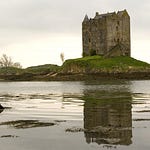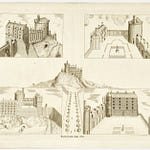Welcome back to "A Scottish Castle, A Day," brought to you by bagtownclans.com. I’m your host, Colin MacDonald, and today, we are journeying to one of Scotland’s most regal and historic ruins: Linlithgow Palace. Nestled in the picturesque town of Linlithgow, West Lothian, just 15 miles west of Edinburgh, this majestic ruin was once the favored residence of the Stewart kings and queens and remains one of Scotland’s grandest royal palaces.
The first records of Linlithgow date back to November 1301 when King Edward I of England, while enforcing John Balliol’s claim to the Scottish throne, used Linlithgow as a military base. Edward quickly recognized the site’s strategic importance, located on the main route between Edinburgh and Stirling. The English King oversaw the construction of a defensive fortification, although this early version was primarily built of wood and earth. During the siege of Stirling Castle in 1304, Linlithgow became a critical supply base. After the Battle of Bannockburn in 1314, the town and its fort returned to Scottish control, marking the start of its royal legacy.
In 1337, King David II granted the site to Sir John Cairns to prepare for the king’s arrival. The early structures, including a royal manor, were significantly repaired, and by 1343, King David held court there. However, the true transformation of Linlithgow Palace began after a catastrophic fire in 1424 devastated both the town and the royal residence. King James I seized the opportunity and embarked on rebuilding the palace, laying the foundation for what we see today.
The construction of Linlithgow Palace as a royal residence continued through the reign of James I and his successors, each monarch leaving their mark on the design. James III (1460–1488) welcomed the exiled King Henry VI of England at the palace in the late 15th century. His son, James IV, further developed the palace into a modern Renaissance residence. He added the west range, completing the courtyard structure that still stands in ruins today. James IV’s marriage to Margaret Tudor in 1503 solidified Linlithgow’s importance as a royal residence. The palace was granted to her as a dower house, and it was here, in 1512, that their son, James V, was born.
But perhaps Linlithgow’s most famous royal birth took place in December 1542, when Mary, Queen of Scots, was born in the palace. Mary’s birth marked Linlithgow as a site of profound historical importance, though she herself spent little time in the palace. Her mother, Mary of Guise, had previously compared Linlithgow favorably to the grand châteaux of France, praising its princely grandeur.
The palace continued to be a favored residence of Scottish royalty through the reign of James VI, but it was already beginning to decline. In 1607, the north range collapsed, though James ordered its rebuilding in the Renaissance style, which was completed by 1624. Despite these efforts, the palace saw fewer royal visitors after the Union of the Crowns in 1603, when the court shifted to London.
During the turbulent years of the 17th century, Linlithgow briefly became a military stronghold once again. In 1650, Oliver Cromwell spent the winter there, and in 1745, Bonnie Prince Charlie used it during his Jacobite campaign. However, its royal days were officially over, and following the disastrous fire set by the Duke of Cumberland’s troops in 1746, the palace was left roofless and abandoned.
Today, Linlithgow Palace stands as a beautiful ruin, open to the skies but retaining much of its architectural splendor. The remains of the Great Hall, the ornate courtyard fountain, and the magnificent views over Linlithgow Loch are testament to its former glory. Historic Environment Scotland now manages the palace, and it remains a popular tourist attraction, drawing visitors from around the world to explore its halls, climb its towers, and imagine the life of Scottish monarchs who once walked its corridors.
Though roofless, the palace has found new life in the arts. It has been featured in TV series such as Outlander, where its medieval and Renaissance atmosphere serves as a perfect backdrop for time-traveling romance. The palace also hosts the annual "Party at the Palace" music festival, which has become a beloved event, bringing modern life to the historic grounds.
There are even whispers that Linlithgow might still have some royal residents—of the ghostly variety. Many say the specter of Mary of Guise haunts the palace halls, watching over the home where her daughter, Mary, Queen of Scots, was born.
Linlithgow Palace is much more than just a ruin; it’s a place where Scotland’s history—its wars, its monarchs, its triumphs, and its tragedies—comes to life. Whether you’re exploring its stone passages or looking out over the tranquil Linlithgow Loch, the palace continues to capture the imagination of all who visit.
Thank you for joining us on this episode of "A Scottish Castle, A Day." We hope you’ve enjoyed learning about the rich history of Linlithgow Palace. Be sure to join us again tomorrow as we journey to another one of Scotland’s legendary castles. I’m Colin MacDonald, and as always, Slán go fóill.










